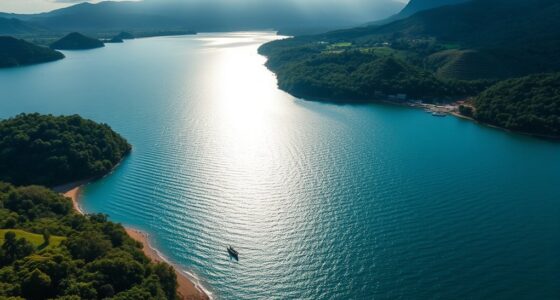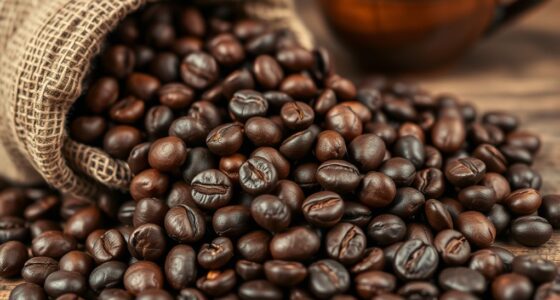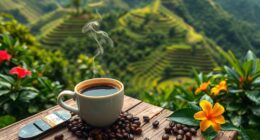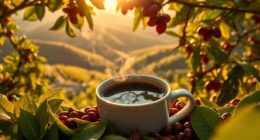Discover Honduras coffee from Santa Bárbara and Marcala, regions known for rich volcanic soil, high altitudes, and consistent rainfall that create ideal conditions for premium beans. These areas focus on sustainable farming practices, selective harvesting, and careful roasting to highlight bright acidity and complex flavors. The local craftsmanship and tradition guarantee each cup reflects the vibrant, layered profiles these regions are famous for. Continue exploring to uncover even more about these exceptional coffee origins.
Key Takeaways
- Santa Bárbara and Marcala benefit from rich volcanic soils and high altitudes, producing distinct, flavorful coffee beans.
- Sustainable farming practices and selective harvesting ensure high-quality, complex coffee profiles from these regions.
- The regions are known for bright acidity, aromatic complexity, and balanced bodies in their coffee offerings.
- Roasting techniques highlight regional flavors, with light to dark profiles emphasizing acidity, caramel, or smoky notes.
- Local expertise and traditional methods enhance coffee quality, reflecting regional pride and craftsmanship.

Ever wondered what makes Honduran coffee stand out on the global stage? It’s the perfect blend of ideal growing conditions, skilled coffee farming, and meticulous roasting techniques. Honduras’s rich volcanic soil, high altitudes, and consistent rainfall create an environment where coffee beans thrive, giving the final product a unique flavor profile. When you explore the world of Honduran coffee, especially from regions like Santa Bárbara and Marcala, you begin to appreciate the dedication behind each cup.
Coffee farming here isn’t just about planting beans; it’s a careful process that involves selecting the best varieties suited to local conditions. Farmers often employ sustainable practices, guaranteeing the land remains fertile for generations. They pay close attention to every detail, from shade management to harvest timing, to assure that only ripe cherries are picked. This selective harvesting preserves the beans’ quality and enhances their distinct flavor notes. The climate and terrain lend themselves to producing beans with bright acidity, balanced body, and complex aromatics that coffee enthusiasts adore.
Careful bean selection and sustainable farming yield Honduran coffee’s vibrant, complex flavors.
Roasting techniques are equally crucial in highlighting the unique qualities of Honduran coffee. Roasters in Santa Bárbara and Marcala are highly skilled, often experimenting with different profiles to reveal the beans’ full potential. Light roasts tend to emphasize the vibrant acidity and fruity notes, while medium roasts bring out a smooth, balanced flavor with hints of caramel and nuts. Some roasters even push toward dark roasts, adding a smoky depth that appeals to those who prefer a bolder taste. Regardless of the approach, the goal is to bring out the beans’ natural characteristics without overpowering them.
When you brew Honduran coffee, you’re experiencing the culmination of thoughtful coffee farming and expert roasting. Each step enhances the beans’ intrinsic qualities, resulting in a cup filled with nuance and clarity. The local communities in Santa Bárbara and Marcala take pride in their craft, often sharing their knowledge and traditions to maintain high standards. This shared passion guarantees every sip you take is a reflection of the region’s rich coffee heritage.
In essence, what sets Honduran coffee apart isn’t just the environment where it’s grown but also the meticulous care applied during coffee farming and roasting. These elements work together to produce a product that’s consistently vibrant, flavorful, and distinctive—truly a treasure for any coffee lover. Additionally, the use of specialized equipment and techniques by roasters helps to further enhance the unique flavor profiles of the beans.
Frequently Asked Questions
What Is the Best Time of Year to Visit Santa Bárbara and Marcala?
You should visit Santa Bárbara and Marcala during the dry season, from November to April, for the best weather considerations. This period offers sunny days and cooler temperatures, making it ideal for exploring coffee plantations and enjoying outdoor activities. Avoid the rainy season between May and October, when heavy rains can disrupt travel plans. Planning your trip during the dry season guarantees a more comfortable and enjoyable experience.
Are There Eco-Friendly Coffee Tours Available in These Regions?
Yes, you can find eco-friendly coffee tours in Santa Bárbara and Marcala. These regions embrace sustainable farming practices and eco tourism initiatives, allowing you to learn about organic cultivation and conservation efforts firsthand. By choosing these tours, you support local communities and promote environmentally responsible tourism. You’ll get an authentic experience while helping preserve the area’s natural beauty and coffee heritage for future generations.
How Do Local Traditions Influence Coffee Farming Practices?
You see that local traditions deeply shape coffee farming practices in these regions. Indigenous rituals influence planting and harvesting, fostering respect for nature and sustainable methods. Community involvement is essential, as farmers share knowledge, support each other, and uphold cultural customs. This blend of traditions and community efforts ensures that farming remains sustainable, preserving cultural heritage while producing high-quality coffee. Your experience of the coffee is enriched by understanding these authentic local practices.
Can Visitors Participate in Coffee Harvesting Activities?
Yes, visitors can participate in coffee picking and enjoy hands-on experiences. When you join a local coffee farm, you’ll get to see firsthand how coffee harvesting is done and even lend a hand during peak picking season. Visitor participation offers a unique opportunity to learn about traditional methods, connect with farmers, and appreciate the hard work behind each cup of Honduran coffee. It’s an authentic, memorable part of your visit.
What Are Some Recommended Local Food Pairings With Regional Coffee?
You might think coffee is best on its own, but try pairing regional coffee with local favorites like traditional breakfast options such as baleadas or tamales. For a sweet twist, enjoy coffee with dessert pairings like tres leches cake or fresh fruit tarts. These combinations highlight the rich flavors of Honduran coffee and enhance your tasting experience, making your visit truly memorable.
Conclusion
As you sip your Honduran coffee, think of Santa Bárbara and Marcala as the roots of a mighty tree, grounding each cup in rich tradition and vibrant soil. Let each bold flavor remind you of the mountains’ whispers and the farmers’ passion, symbolizing resilience and hope. With every taste, you carry a piece of Honduras’s heart—an enduring legacy brewed into every drop, connecting you to a land where dreams are cultivated one bean at a time.









